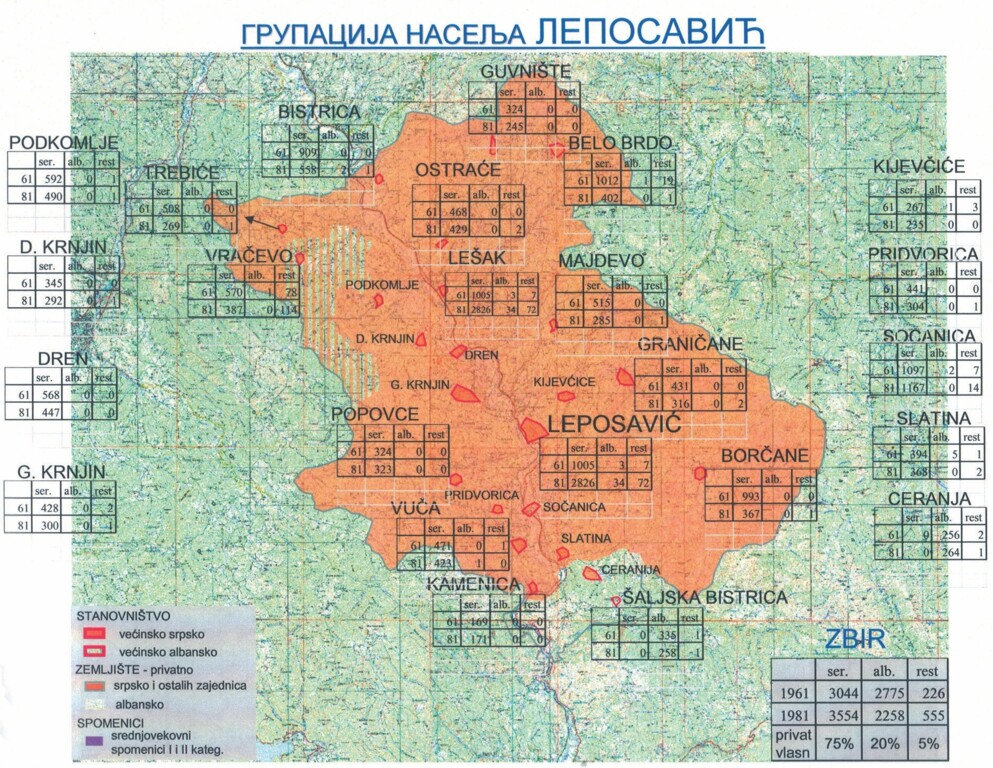Historiography of Leposavić
Leposavić is the northernmost municipality of Kosovo and Metohija. It covers an area of about 750 km², and the town of Leposavić is a modern mining settlement on the southern slopes of Kopaonik. It was formed in the area between the older villages of Leposavić, Ulije, and Tvrđan.
Leposavić is located halfway between the mining areas of Kopaonik and Rogozna and developed thanks to the surrounding mines, most of which have been mentioned since the 19th century. Mining in the Leposavić area existed in ancient times, and thanks to it, the Roman urban settlement Municipium Dardanicum was formed near today's Sočanica.

During the entire Roman rule in Kosovo and Metohija, there was only one other Municipium, Municipium Ulpiana. With the development of mining after World War II, settlements around Leposavić developed rapidly, but Leposavić itself lagged behind Belo Brdo. Only in the 1960s, with the modernization of mining, was a modern settlement more significantly developed, to which residents of the surrounding areas and mining experts from all over Serbia moved.
Leposavić borders Raška and Brus to the north, Kosovska Mitrovica to the south, Krušumlija and Podujevo to the east, and Novi Pazar to the west.
The territory of the municipality of Leposavić includes the southwestern parts of Kopaonik Mountain and its slopes, among which Šatorice and the southwestern slope with Pančić's peak stand out for their natural beauty. That's why we chose the name of this mountain for our cultural and artistic association. It is worth mentioning a number of enthusiasts from this region who have fought with their work and effort to make cultural life richer, and with their music and traditional singing drew attention to the less attractive aspects of ethnological and ethnographic work: Milomir and Radomir Martinović, Batica Nikolić, and traditional singers Luka and Tala Blagojević, Mima Đuričić, Dragomirka from Lešak, Proka from Sočanica, Rata and Zlata Vukašinović, Zoran Vukadinović from Drenova, Kosta and Milo Ćirković. Their work has greatly helped us as a basis for new creation. Prof. Dr. Valentina Pitulić made an exceptional contribution to the development of cultural-artistic amateurism, whose professional advice contributed to the quality of the program.
After the war conflicts of the 1990s, Leposavić spiritually revived. A large temple dedicated to St. Basil of Ostrog in the Byzantine style was built. The monastery of the Holy Unmercenaries in Vračevo, the church in Drenova, the church of the Dormition of the Most Holy Theotokos in Lešak, the church in Zemanica, the monastery of St. Petka in Leposavić, the monastery of St. John and the church of St. John the Theologian in Sočanica, the monastery of St. Petka in Ceranjska Reka, and new churches in Vuča and Kamenica, as well as the church on the hill of Dublje between the villages of Plakonice and Duboka, were also renovated and built.
The cultural life of Leposavić is organized by the cultural center "Sava Dečanac," which houses the cultural and artistic association "Kopaonik" and the National City Library "Saint Sava." In the hall of the cultural center "Sava Dečanac," there is a permanent museum exhibition "Archaeological and Ethnographic Heritage of Kosovo and Metohija - Heritage for the Future" as a joint work of the Museum in Priština, the Center for Culture "Sava Dečanac," and the KUD "Kopaonik." The territory of the municipality of Leposavić has not been the subject of research until recent years, so this task was taken on by KUD "Kopaonik" as a collector of folk melodies.
The independent research work of this society has resulted in the expansion of its activities to collecting authentic folk costumes of these regions, as well as recordings and audio recordings of folk melodies that accompanied the everyday life of these areas.
The characteristic of the music of Leposavić and the places surrounding it is a completely autonomous style of melody, which greatly resembles Montenegrin 'orske' songs. Apart from the vicinity of Leposavić, this style of singing can also be found in some regions around Peć. The reason for this specificity of musical expression and its distinctiveness from other regions of Kosovo and Metohija can be found in historical circumstances, namely the migrations of the population during the 18th century, when the northern belt of Kosovo was settled by a large number of families from Montenegro, while the locals of Kosovo continued their journey towards Serbia. Even today, it is rare to find a family in Leposavić that does not know of its Montenegrin origin.